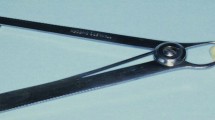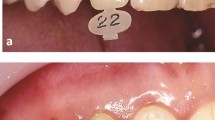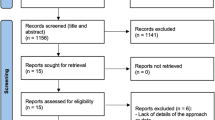Abstract
Correctly managing interdental papillae is a key step in producing satisfactory, interproximal, direct composite restorations. This article discusses techniques to facilitate the restoration of sub-gingival cavities and suggests a decision-making workflow that can be applied in this challenging situation.
Similar content being viewed by others
Key points
-
Considers the issues in managing sub-gingival interproximal margins for direct adhesive restorations.
-
Describes techniques for managing the papillae where restorative margins are sub-gingival.
-
Provides a step-by-step decision-making workflow for pragmatic management of sub-gingival, interproximal, direct composite restorations.
Introduction
Predictably restoring sub-gingival cavities with composite is difficult and an area where UK general dental practitioners (GDPs) lack confidence.1 The problems arise from an inability to isolate the sub-gingival cavity and difficulties in creating the correct matrix profile, which lead to an inability to produce an adequate contact point. While in the past dentists could perhaps avoid placing composites in this type of situation, the phase-down and planned phase-out of amalgam has heightened the need to find predictable solutions to these commonly encountered problems.
A key initial step in addressing these issues is to ensure that the wedge is appropriately positioned below the base of the cavity. This is dictated by the position and subsequent management of the papillae. The papillae must be displaced or partially removed to facilitate this process in deep sub-gingival cavities. When this step has been adequately managed, it facilitates effective isolation, change for matrix placement and ultimately, successful restoration of the tooth.
Rationale for papilla management
Effective wedging
Correct wedge placement (Fig. 1) is integral to the placement of a successful interproximal composite restoration in that it fulfils the following objectives:
Representation of how papillae height affect wedge and matrix configuration; a) and b) supra-gingival cavity, no modification required; c) and d) sub-gingival cavity without modifying the papillae results in matrix distortion; e) and f) sub-gingival cavity with displacement or partial removal of the papillae allows placement of the wedge below the base of the cavity and effective matrix configuration
Seals the base of the box, preventing contamination of the cavity, while also preventing apical extrusion of restorative material beyond the cavity margin
Provides separation of teeth, aiding the subsequent formation of a contact point when the matrix is removed.
After completing a deep interproximal cavity preparation, the papillae will often lie above the base of the cavity (Fig. 1c). This can prevent the wedge from seating below the cavity margin with subsequent failure to meet the above objectives, resulting in many deleterious effects (Fig. 1d).
Isolation
In deep cavities it is normally beneficial to prepare the periphery of the cavity without a rubber dam (RD) in place, or by implementing a split dam. This allows the operator access to the papilla should modification be indicated. Although RD isolation is not a prerequisite for successful posterior composite restorations, it is essential if adequate relative moisture control cannot be achieved. It also helps to limit contamination of the pulp when finalising central cavity preparation, should an exposure occur. In deep boxes, relative moisture control becomes increasingly challenging and use of RD increasingly important.
Making the cavity margin supra-gingival makes RD placement much easier as it will commonly sit down below the cavity margin, where before it was impeded by the papillae. Clamp selection is also integral to this process as wings can impede the horizontal placement of the wedge below the cavity margin (Figs 4f and g).
Papilla management
Pre-wedging
The viscoelastic nature of the gingival tissues will often allow the papillae to be displaced below the cavity margin, so that the wedge can seat in an appropriate position. Displacement of the gingival tissues can be expedited by a procedure known as pre-wedging. This involves placing a wedge before the cavity preparation is performed. Wooden wedges are more effective than most plastic wedges for this procedure because they don't have a concavity on their underside (Fig. 2). The largest wedge that can be placed through the interproximal 'space' should be selected to maximise the displacement and can be incrementally inserted during the preparation as the teeth move in their periodontal ligament. When the cavity preparation is completed, the periphery of the wedge should be removed and the position of the papillae assessed in relation to the cavity. The cavity is only suitable for restoring if the displaced papillae lie below the cavity margin and can accommodate a correctly placed wedge above them (Fig. 3a, b).
Wedge modification
It is also important that no part of the wedge interferes with the emergence profile of the contoured matrix by projecting above the base of the cavity (Fig. 3b). This can also prevent the formation of a contact point. Wooden wedges can be modified to achieve this aim, using either a bur or a scalpel (Fig. 3c, d, e), or a low-profile plastic wedge can be employed (Figs 2 and 3f).
Partial papillectomy
A partial papillectomy involves the surgical removal of part of the papilla. It is indicated if, after pre-wedging, the base of the cavity is not exposed and a wedge cannot be placed so that it lies horizontally beneath the cavity margin (Fig. 4a, b, c).
a) Pre-wedging; b) pre-wedging ineffective. Wedge cannot be placed below base of cavity. Sufficient band of keratinised gingiva to allow partial papillectomy; c) partial papillectomy with Thermacut bur allowing seating of RD and horizontal placement of wedge below cavity margin; d) tooth safe Thermacut burs used to perform partial papillectomy; e) rubber dam inverted and sitting below base of cavity; f) example of wedge trimming required to avoid clamp wing, facilitating horizontal placement below cavity margin; g) effective matrix placement facilitated. A wingless clamp would have made wedging easier
Partial papillectomy can be performed in a number of ways. Electrosurgery units or lasers are often employed for this purpose (Fig. 5a), but may not be accessible to many dentists due to the expense of the equipment. Therefore, perhaps the most effective and accessible technique for GDPs is rotary curettage.2 In this procedure the friction and heat created by a rotating bur simultaneously cuts and cauterises the papilla (Fig. 4c). The bur used for rotary curettage should be smooth (Fig. 4d) to prevent inadvertent damage to adjacent teeth and should be used without water to allow sufficient heat to cauterise. Rotary curettage should be performed following infiltration of the papillae with local anaesthetic (preferably containing a vasoconstrictor to minimise bleeding). The procedure can then be completed by stroking the tissues in a controlled manner, taking care not to overheat the underlying bone. Tissue is removed until the base of the cavity is exposed and a wedge can lie horizontally below it (Fig. 4c). Manufacturers have produced ceramic burs specifically for rotary curettage but a Thermacut Bur (Dentsply Sirona, USA) (Fig. 4d) is a low cost and effective alternative.
Rotary curettage often results in a fairly bloodless field (Fig. 4c). Bleeding can be controlled through styptic application, however rubber dam application is strongly advised after this procedure to ensure any residual bleeding does not interfere with the restorative process (Figs 4e, f and 5c, d). Following restoration, the patient can be discharged without the need to provide a soft tissue dressing. It is prudent to warn the patient that they may experience post-operative discomfort relating to this procedure, but experience suggests that this is minimal, if reported at all by patients at follow-up.
Partial papillectomy risks
Soft tissue healing is often rapid following tissue removal,3 and experience suggests complications requiring further intervention are very rare, but there are some potential complications which are discussed below.
Papilla recession
It is possible that the papilla will not refill the interdental space, leaving a black triangle. Patients who are especially at risk are those who have a low position of the alveolar crest, as may be seen in patients who have suffered bone loss as a result of periodontal disease without soft tissue recession. Papilla filling of the interdental space is dependent on many parameters, such as the position of the alveolar crest in relation to the contact point position, root separation of adjacent teeth at the crest, and emergence profile.4
It should be remembered that one of the primary reasons for the partial papillectomy is to allow recreation of a more anatomical emergence profile than would otherwise be possible. This will therefore establish a more cervical position of the contact point than if the papillae were maintained, thus favouring the re-establishment of papillae that fill the interproximal space.
Keratinised tissue
Assessing the amount of keratinised tissue before partial papillectomy is advised, as tissue resection beyond a band of keratinised tissue should be avoided to preserve the attached gingivae. Having said this, there is a preponderance of evidence that suggests the presence of attached gingivae has no effect in terms of preventing attachment loss.5 There is some limited evidence to support reduced recession and inflammation of tissues around teeth with sub-gingival restorative margins with thick biotypes and more than 2 mm of keratinised tissue.6,7
Biologic width violation
The junctional epithelial and supra-crestal connective tissue attachment to a tooth is termed the biologic width (BW). When a restorative margin impinges on this attachment, it is often termed BW violation and can potentially lead to persistent inflammation of the marginal gingiva, recession or tenderness; or it can lead to bone remodelling.8 There is, however, evidence to suggest that such sequelae, when associated with sub-gingival margin placement, are self-limiting over a long time period.9
Assessment
It is therefore prudent to assess the bone level adjacent to the cavity margin before papilla removal to assess potential issues. This enables the risks to be conveyed to the patient. This can be estimated using a pre-operative bitewing radiograph, and established through bone sounding.8 If, following cavity preparation, the linear dimension from the base of the cavity to the bone crest is greater than 2 mm, as measured with a Williams periodontal probe, BW violation is unlikely.10 If it is much greater, recession is possible; if it is less, BW violation is possible. This potential BW violation does not preclude partial papillectomy, because the compromised situation has to be managed. It must be remembered that BW dimension is very variable,11 and its status and dimension when associated with a soft carious lesion is uncertain.12 Re-establishment of BW, and the dimension of that re-establishment in such situations is also uncertain, so the parameters for individual responses are very difficult to define. The patient must also understand the compromised situation they are in, and expectations should be accordingly managed.
Alternatives to partial papillectomy
We have outlined some of the potential complications with partial papillectomy. They must be viewed in the context of a balanced discussion of the advantages and disadvantages of alternative management options. These alternative approaches are more complex and are therefore often outside the scope of practice of general dentists. Crucially, they are also not without complications.
Surgical crown lengthening (SCL) with osseous recontouring or osstectomy is an option which is performed in an attempt to allow the re-establishment of BW. When performed with an apically repositioned flap, it also has the benefit of maintaining the zone of keratinised tissue, though this seems to have limited importance.5,6,7 SCL commonly has financial and biological costs however. It can be a technically difficult surgical procedure to perform and is commonly insufficiently performed even by experienced, skilled operators.13 Interproximal bone removal doesn't involve a single tooth (where an adjacent tooth is present), as bone removal will also affect the adjacent tooth. This can cause loss of attachment and recession, which may then expose further root dentine in an already caries-prone individual. This would also increase the crown to root ratio, which may have biomechanical sequelae. Exposure of furcation areas can also have a negative periodontal and caries risk impact, and it may also result in sensitivity.14
Other alternative management strategies include rapid orthodontic extrusion,15 or surgical extrusion;16 although these are usually reserved for heavily broken down teeth where inter-occlusal space is available, and commonly where ferrule needs to be gained, not when placing direct restorations. It is also prudent to consider the restorability of the tooth.
Rational compromises
If the wedge cannot seat appropriately, partial papillectomy to appropriately restore the deep interproximal cavity is strongly advised when the distance from the cavity margin to the alveolar crest is greater than or equal to 2 mm. If this dimension is less than 2 mm, a judgement must be made in conjunction with the patient. The patient and operator must weigh up the potential risks of proceeding with the partial papillectomy against the risks associated with alternative treatments in a shared decision-making process. Given the existing compromised situation, the unknown parameters involved and the potential issues involved with the alternatives, it seems reasonable to proceed with partial papillectomy as a first line intervention for the direct restoration of the deep sub-gingival margin with composite. Experience suggests that this approach is very successful.
Cases completed with a partial papillectomy should be monitored for symptoms consistent with BW invasion or inadequate attached gingivae. If noted, the operator can still consider alternative management options at this point. We have summarised our decision-making workflow in Figure 6.
Conclusion
For primary management of the deep interproximal carious lesion, appropriate papilla management provides the key initial step to effective direct composite restoration. It allows for effective isolation, matrix placement and wedging of the cavity, reducing the potential for overhangs, optimising the bonding process and encouraging the formation of a favourable emergence profile and contact point. Partial papillectomy offers a relatively straightforward solution to the issues faced on a daily basis by GDPs. The patient should always be informed of their compromised situation and engaged in a balanced discussion of potential sequelae and management options.
References
Lynch C D, Farnell D J J, Stanton H, Chestnutt I G, Brunton P A, Wilson N H F. No more amalgams: Use of amalgam and amalgam alternative materials in primary dental care. Br Dent J 2018; 225: 171-176.
Kamansky F W, Tempel T R, Post A C. Gingival tissue response to rotary curettage. J Prosthet Dent 1984; 52: 380-383.
Moskow B S. The Response of the Gingival Sulcus to Instrumentation: A Histological Investigation. 2. Gingival Curettage. J Periodontol 1964; 35: 112-126.
Chang L C. Factors associated with the interdental papilla height between two maxillary central incisors: a radiographic study. J Periodontol 2012; 83: 43-49.
Lang N P, Lindhe J (eds). Clinical Periodontology and Implant Dentistry, 2 Volume Set. 6th ed. Oxford: Wiley-Blackwell, 2015.
Stetler K J, Bissada N F. Significance of the width of keratinized gingiva on the periodontal status of teeth with submarginal restorations. J Periodontol 1987; 58: 696-700.
Tao J, Wu Y, Chen J, Su J. A follow-up study of up to 5 years of metal-ceramic crowns in maxillary central incisors for different gingival biotypes. Int J Periodontics Restorative Dent 2014; 34: e85-e92.
Kois J C. The restorative-periodontal interface: biological parameters. Periodontol 2000 1996; 11: 29-38.
Schatzle M, Land N P, Anerud A, Boysen H, Burgin W, Loe H. The influence of margins of restorations of the periodontal tissues over 26 years. J Clin Periodontol 2001; 28: 57-64.
Matthews D C, Tabesh M. Detection of localized tooth-related factors that predispose to periodontal infections. Periodontol 2000 2004; 34: 136-150.
Schmidt J C, Sahrmann P, Weiger R, Schmidlin P R, Walter C. Biologic width dimensions - a systematic review. J Clin Periodontol 2013; 40: 493-504.
Dragoo M R. Resin-ionomer and hybrid-ionomer cements: part II, human clinical and histologic wound healing responses in specific periodontal lesions. Int J Periodontics Restorative Dent 1997; 17: 75-87.
Herrero F, Scott J B, Maropis P S, Yukna R A. Clinical comparison of desired versus actual amount of surgical crown lengthening. J Periodontol 1995; 66: 568-571.
Bateman G, Saha S, Chapple I L. Contemporary Periodontal Surgery: An Illustrated Guide to the Art Behind the Science. New Malden: Quintessence, 2007.
Faria L P, Almeida M M, Amaral M F, Pellizzer E P, Okamoto R, Mendonca M R. Orthodontic Extrusion as Treatment Option for Crown-Root Fracture: Literature Review with Systematic Criteria. J Contemp Dent Pract 2015; 16: 758-762.
Das B, Muthu M S. Surgical extrusion as a treatment option for crown-root fracture in permanent anterior teeth: a systematic review. Dent Traumatol 2013; 29: 423-431.
Acknowledgements
The authors wish to acknowledge Nick Marshall for his production of the diagrams in Figure 1.
Author information
Authors and Affiliations
Corresponding author
Rights and permissions
About this article
Cite this article
Bailey, O., O’Connor, C. Papilla management in sub-gingival, interproximal, direct composite restoration: a key step to success. Br Dent J 226, 933–937 (2019). https://doi.org/10.1038/s41415-019-0412-6
Published:
Issue Date:
DOI: https://doi.org/10.1038/s41415-019-0412-6
This article is cited by
-
Matrix transfer techniques for direct paste composite resins
British Dental Journal (2022)
-
Sub-gingival posterior composites: How confident are you?
BDJ In Practice (2022)
-
Preserving pulp vitality: part two - vital pulp therapies
British Dental Journal (2021)
-
Sectional matrix solutions: the distorted truth
British Dental Journal (2021)
-
Preserving pulp vitality: part one - strategies for managing deep caries in permanent teeth
British Dental Journal (2021)









